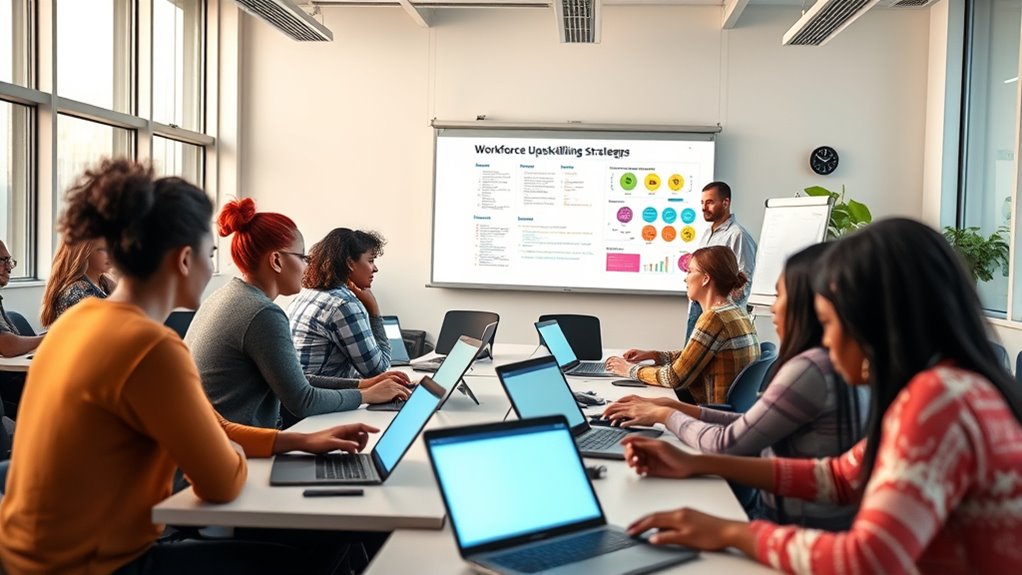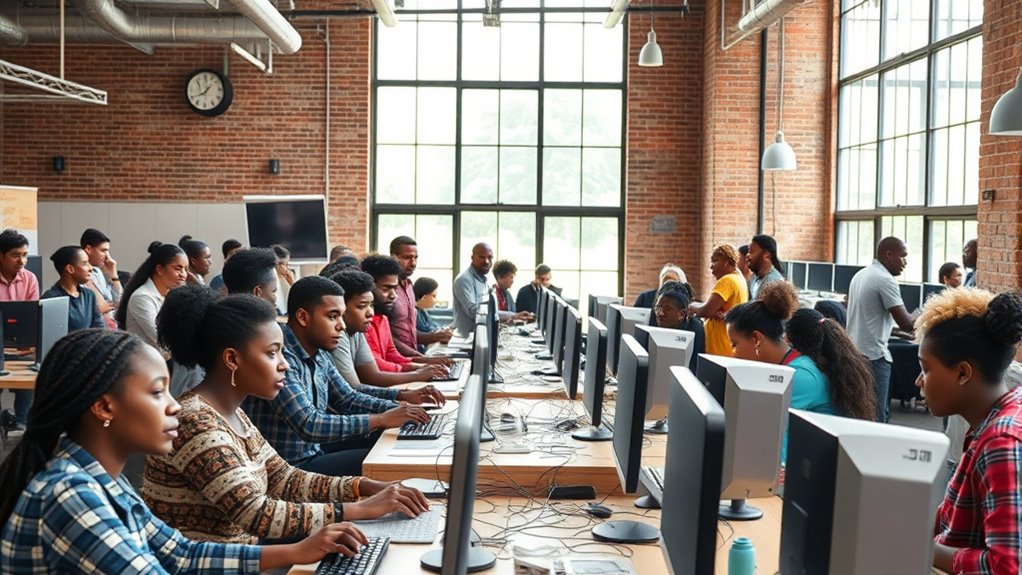The US and EU recognize automation’s impact on jobs and are implementing strategies to reskill workers effectively. They’re launching initiatives focused on digital, AI, and sector-specific skills—especially in transport and digital sectors—to bridge the skills gap. Policies emphasize inclusive, flexible, lifelong learning, and collaboration among governments, businesses, and educators. As they adapt, you’ll discover how these efforts help build resilient, future-ready workforces, ensuring you stay ahead of the changing job landscape.
Key Takeaways
- Both the US and EU are implementing policies to promote lifelong learning and upskilling to mitigate job displacement from automation.
- Sector-specific strategies focus on digital skills, AI, and green technologies to prepare workers for emerging roles.
- Governments, businesses, and educators collaborate to develop accessible, flexible reskilling programs targeting vulnerable communities.
- The EU’s initiatives include projects like RESKILLING and AI Talent Pool, emphasizing social inclusion and industry-specific training.
- The US and EU aim to foster workforce resilience through continuous learning, innovation, and strategic investments in digital transformation.
The Urgency of Reskilling in the US and EU

As automation accelerates across industries, the urgency of reskilling in the US and EU becomes clear. You need to stay competitive in a rapidly changing job market where traditional roles are disappearing. Automation and AI threaten millions of jobs, and without new skills, workers risk long-term unemployment. Governments recognize this threat and are pushing initiatives to help you adapt. Reskilling isn’t just about individual growth; it’s essential for national economic stability and global competitiveness. If you don’t keep pace, you could fall behind as industries evolve. The pressure is on to develop policies and programs that support continuous learning, ensuring workers like you can transition into emerging roles and secure your future in an increasingly automated world. Maximize your skills to stay ahead in this evolving landscape.
Key EU Initiatives Driving Workforce Transformation

The EU is taking targeted actions to drive workforce transformation amid the rapid advancements in automation and digital technologies. You’ll see initiatives like the RESKILLING Project, which focuses on adapting the transport sector through workforce development and social inclusion. The Digital Europe Programme invests heavily in digital skills, especially in AI, to prepare workers for emerging roles. Efforts like the AI Talent Pool aim to build a robust talent pipeline across Europe. The Strategic Foresight Report highlights AI-driven labour disruptions as a key challenge, prompting proactive responses. Additionally, the ARISA Project accelerates AI upskilling and reskilling efforts, helping to close the skills gap. To support these initiatives, many regions are adjusting banking hours to better serve the evolving needs of workers and businesses. These initiatives collectively aim to equip workers for the evolving job market and sustain Europe’s global competitiveness.
Addressing the Skills Gap in a Changing Economy

You need to recognize that bridging the skills divide is essential for workers to stay relevant in today’s evolving economy. By fostering workforce flexibility, you can help employees adapt quickly to new roles and technologies. Addressing these challenges head-on guarantees a resilient labor market and sustained economic growth. Implementing targeted training programs and upskilling initiatives can further accelerate this transition.
Bridging the Skills Divide
Bridging the skills divide becomes essential when rapid technological change outpaces your current abilities. As automation advances, the gap widens between existing skills and those needed for new roles. To illustrate, consider this table showing key skill areas:
| Skill Area | Current Gap | Required Skills |
|---|---|---|
| Digital Literacy | Limited familiarity | AI, data analysis, coding |
| Soft Skills | Communication, teamwork | Adaptability, problem-solving |
| Technical Skills | Basic understanding | Automation, cybersecurity |
Addressing these gaps requires targeted training, accessible resources, and collaboration among governments, industry, and educators. Additionally, fostering digital literacy across all sectors can accelerate adaptation to technological advancements. By focusing on upskilling and reskilling, you can stay competitive and ensure a smoother transition into the future of work.
Enhancing Workforce Flexibility
As economies evolve rapidly due to technological advancements, enhancing workforce flexibility becomes essential for adapting to shifting job requirements. You need to develop the ability to switch roles, learn new skills quickly, and stay resilient amid change. Here’s how to stay adaptable:
- Embrace lifelong learning through online courses and training programs.
- Seek cross-sector experience to diversify your skill set.
- Stay open to new roles and industries, even if they seem outside your comfort zone.
Strategies for Inclusive and Equitable Reskilling

How can we guarantee that reskilling efforts reach all workers equally? You can promote inclusivity by designing programs that target underserved communities, ensuring access regardless of income or location. Providing financial support, such as stipends or subsidies, removes economic barriers that prevent participation. Collaborate with local organizations to reach diverse groups and tailor training to different skill levels and learning styles. Use multiple delivery methods—online, in-person, and hybrid—to accommodate varying needs. Transparent communication about available opportunities and clear pathways to employment encourage wider engagement. Ensuring that reskilling initiatives are culturally sensitive and accessible helps reduce disparities. Additionally, integrating payment processing solutions into training programs can facilitate streamlined financial transactions and support services for participants. By prioritizing equity in planning and execution, you create a fairer process that offers all workers a genuine chance to adapt and thrive amid automation.
The Role of Education and Continuous Learning

Education and continuous learning are essential to keep pace with rapid technological changes and guarantee workers remain relevant in the evolving job market. To succeed, you should focus on three key areas:
Embrace lifelong learning, adapt to industry changes, and foster a growth mindset to stay relevant in a tech-driven job market.
- Embrace lifelong learning by regularly updating your skills through online courses, workshops, or certifications.
- Seek out adaptable education programs that respond to industry shifts, ensuring your training stays current.
- Cultivate a growth mindset that encourages curiosity and resilience, helping you navigate new technologies confidently.
Fostering Collaboration Among Stakeholders

Building effective reskilling initiatives requires strong collaboration among governments, businesses, and educators. You need these groups working together to identify skills gaps, develop relevant training programs, and share resources. Governments can provide funding and policy support, while businesses offer practical insights and real-world opportunities. Educators design curricula that meet current and future workforce needs, ensuring workers gain relevant skills. Open communication and shared goals foster trust and coordination. You should encourage innovation and flexibility, adapting strategies as technology evolves. Joint efforts can streamline pathways for workers, making reskilling more accessible and efficient. Ultimately, this collaboration maximizes resource use, accelerates skill development, and creates a resilient workforce ready for the challenges of automation. Incorporating training programs that are responsive to changing job demands is essential for success.
Sector-Specific Reskilling: Focus on Transport and Digital Jobs

As automation transforms the transport and digital sectors, targeted reskilling becomes essential to prepare workers for emerging roles. You need to focus on specific skills that match the evolving demands, ensuring a seamless transition. Here are key areas to consider:
- Transport Sector: Learn about autonomous vehicle operation, maintenance, and safety protocols to stay relevant as driver roles decline.
- Digital Jobs: Develop expertise in AI, cybersecurity, and data analysis to meet the growing demand for tech-driven roles.
- Cross-Sector Skills: Enhance problem-solving, adaptability, and digital literacy to navigate both transport and digital job markets effectively. Maximize space and organization can also play a role in creating efficient work environments for new roles in these sectors.
Economic and Social Benefits of Strategic Reskilling

Strategic reskilling offers significant economic and social benefits by enabling workers to adapt to rapid technological changes and emerging job markets. When you reskill, you help reduce unemployment and support economic stability. This process boosts workforce productivity, making industries more competitive globally. Socially, reskilling fosters inclusion by providing opportunities for all workers, especially those displaced by automation. It can also decrease inequality by empowering individuals to access new roles in growing sectors like digital and green tech. As you acquire new skills, you contribute to a more resilient economy that can better withstand technological disruptions. Additionally, embracing diverse beach experiences can inspire innovative approaches to workforce development and community engagement. Ultimately, strategic reskilling creates a more adaptable workforce, enhances social cohesion, and drives sustainable economic growth for your community and nation.
Challenges and Opportunities in Automation Adoption

While reskilling initiatives open significant economic and social advantages, adopting automation presents its own set of challenges and opportunities. You’ll face hurdles like the skills gap, where current workers lack the technical expertise needed for new roles. But, automation also offers opportunities to create innovative jobs and boost productivity. Consider these key points:
- Skills Gap: Bridging the divide between existing skills and those demanded by new technologies is essential.
- Job Transformation: Automation displaces some roles but also opens pathways for roles requiring advanced technical skills.
- Social Inclusion: Ensuring all workers have access to reskilling helps maintain social stability and economic growth.
- Incorporating Pimple Patches into wellness routines exemplifies how targeted solutions can enhance overall well-being amidst technological shifts.
Future Directions for Workforce Adaptation

The future of workforce adaptation hinges on continuous, proactive efforts to equip workers with the skills needed for rapidly evolving technologies. You should prioritize lifelong learning, ensuring workers can update their skills as new tools and processes emerge. Governments, businesses, and educators must collaborate to develop flexible training programs that address shifting job demands. Emphasizing digital and green skills will open new opportunities and help workers transition into emerging sectors. Tailoring reskilling strategies to specific industries, like transportation and manufacturing, enhances effectiveness. Encouraging innovation and co-creation will foster innovative approaches to workforce development. By fostering a culture of adaptability and resilience, you can better prepare the workforce to navigate automation’s challenges and seize future economic opportunities.
Frequently Asked Questions
How Will Reskilling Programs Ensure Long-Term Employment Stability?
Reskilling programs guarantee your long-term employment stability by helping you adapt to changing technologies and job requirements. They provide continuous learning opportunities, equipping you with new skills for emerging sectors. By promoting lifelong learning and fostering collaboration between governments, businesses, and educators, these programs create a resilient workforce. This proactive approach reduces unemployment risks, enhances your employability, and keeps you competitive in a rapidly evolving job market.
What Specific Technologies Are Prioritized in EU and US Reskilling Efforts?
You should focus on emerging technologies like artificial intelligence, machine learning, robotics, and data analytics, which are central to EU and US reskilling efforts. Both regions prioritize developing skills in these areas to stay competitive and adapt to automation. Additionally, cloud computing, cybersecurity, and green technology are emphasized to prepare workers for future job markets, ensuring they can operate and innovate with these advanced tools effectively.
How Are Small Businesses Supported in Adopting Reskilling Initiatives?
Oh, lucky small businesses—destined to thrive in the reskilling revolution, right? You’re supported through targeted grants, training subsidies, and accessible online courses designed just for you. Governments streamline processes, reduce bureaucratic hurdles, and encourage partnerships with local training providers. The goal? Make it so easy, even a busy entrepreneur can reskill without pulling their hair out. Because nothing says “future-proof” like taxpayer-funded support for your tech-savvy ambitions.
What Measures Are in Place to Prevent Skill Obsolescence?
You can stay ahead of skill obsolescence through continuous learning and upskilling programs supported by government and industry initiatives. Take advantage of online courses, workshops, and training programs designed to keep your skills current with technological advancements. Engage in lifelong learning, seek new certifications, and stay informed about emerging trends. This proactive approach guarantees you remain competitive and adaptable in a rapidly changing job market.
How Will Reskilling Address Regional Disparities Within the US and EU?
You can bridge regional disparities by focusing reskilling efforts on underserved areas, guaranteeing access to digital training and education. By collaborating with local governments, businesses, and community organizations, you help tailor programs that meet regional needs. Promoting inclusive policies and investing in infrastructure ensures everyone benefits, reducing inequality. As you support workers in diverse regions, you strengthen economic resilience and create equal opportunities across both the US and EU.
Conclusion
While reskilling may seem costly or time-consuming, investing now guarantees you stay relevant in a rapidly evolving job market. Embracing change isn’t just about avoiding job loss—it’s about seizing new opportunities and building a resilient workforce. By actively participating in continuous learning, you help shape a future where automation enhances human potential, not replaces it. So, don’t resist change—embrace it as your chance to thrive in tomorrow’s economy.









